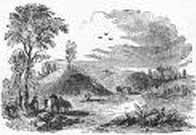Weber Avenue Site's Sensitive Issues
The excavation of Native American graves is a sensitive matter, one that requires cooperation, respect, and collaboration with today's California Indian community.
In addition to all the artifacts collected at the Weber Avenue site, something even more important was found. Two intact human burials were revealed at the site. Archaeologists found the almost complete remains (skeletons) of two women buried deep in the earth. They shared a single grave and were decorated by Olivella shell beads. Careful screening of back-dirt piles also revealed the partial remains of sever other adults and seven juveniles that ranged in aged from an unborn fetus to a child seven- or eight-years old. While artifacts and soil types tell us much about how people lived in prehistoric times, the delicate excavations of a burial site can help us better understand who those people actually were.
 In general, Native American grave sites are excavated by archaeologists only when they face the threat of destruction. In the case of Weber Avenue site, the unexpected discovery of a burial is exactly what brought archaeologists to the site in the first place.
In general, Native American grave sites are excavated by archaeologists only when they face the threat of destruction. In the case of Weber Avenue site, the unexpected discovery of a burial is exactly what brought archaeologists to the site in the first place.
It is also brought in a "Most Likely Descendant." When a grave is accidentally disturbed in California, a number of state and federal laws are in place to determine what will happen next. In the case of Weber Street site, a Native American representative was called in and asked to make recommendations about appropriate next steps. This is a way of protecting the sacred nature of a burial site and receiving guidance on how best to handle a sensitive archaeological issue. How grave sites are treated is something that today's American Indian tribes care about very much.
In accord with the law and wishes of tribal members, all archaeological excavations at the Weber Street site were monitored by a California Indian descendant. This means that whenever a shovel was put in the ground or when any decisions were made, a tribal person was on hand to give his or her opinion and to make sure that his or her ancestors were treated with respect and sensitivity. Today, many archaeologists and California Indian tribes work in a spirit of partnership and collaboration. The human remains recovered from the Weber Street site will be reburied in a special place chosen by the California Indian community.
Sixteen individuals were found buried at the Weber Street site.
- One (1) unborn fetus, 4 - 5 months in gestation
- Four (4) infants, 0 - 6 months old
- One (1) child, 2 - 4 years old (+/- one year)
- One (1) child, 7 - 8 years old
- One (1) woman, 35 - 40 years old
- One (1) woman, 40 - 45 years old
- Seven (7) adults, ages undetermined
In 2009, the Native American remains were reburied in accordance with the law and wishes of the Native American representative in close proximity to the location of the original discovery.
External Links
There are currently no external links.
This City of Stockton web page last reviewed on --- 5/12/2015
